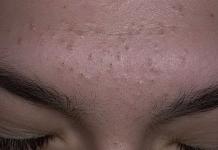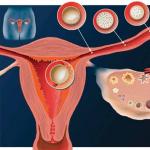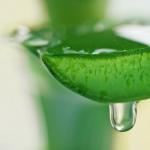Ekaterina Rakitina
Dr. Dietrich Bonhoeffer Klinikum, Germany
Reading time: 4 minutes
A A
Article last updated: 02/13/2019
Babies in the first months of life are prone to runny nose. According to statistics, children are most worried about swelling of the nasal mucosa. This fact is due to the organs of the nasopharynx that have not yet fully formed. In infants, the special structure of the nasal cartilage does not allow the mucus to be easily removed from the nose.
Folk remedy for colds
Infants under one year old cannot breathe through their mouths, therefore, even during a runny nose, they breathe through their noses, so swelling of the mucosa causes them serious inconvenience. It is difficult for the child to eat, sleep, he often cries. Drops that have a vasoconstrictive effect are not recommended for infants, and washing the nose is a very difficult task. In this regard, the treatment of rhinitis in infants is very different from the treatment in adults.
In such situations, you can treat the child with folk remedies. Among these, the treatment of the common cold in children with aloe juice. Thanks to this plant, you can save your baby from a runny nose in the shortest possible time, while strengthening his immunity. Aloe juice is used as a prophylactic against various infections.
Aloe has a whole list of healing properties. This plant was used by our grandmothers for medicinal purposes. Modern manufacturers add its juice to various medicines, including those for children.
The beneficial properties of aloe are as follows:- the juice of the plant contains trace elements, vitamins that act locally on the immune system, due to which the body's resistance increases;
- aloe juice is able to destroy germs, infections. This property is due to the antiseptic effect;
- the plant has an analgesic effect, it helps to relieve swelling of the mucous membrane.
Aloe juice begins to act very quickly and does not contain toxic substances and allergens, so it will not harm the child's body.
How to treat with aloe correctly?
In order to preserve the beneficial properties of aloe, it should be used against the common cold in children correctly. The mucous membrane of babies up to a year old is very delicate, so you need to pay attention to the method of preparing the remedy so as not to harm it. Under the condition of proper use, a runny nose in a child will pass much faster, and the condition of the child will improve as soon as possible.
If you drip a few drops of aloe juice from a freshly picked leaf of a plant, you can harm the nasal mucosa of a child, since the liquid contains a large number of active ingredients. In this connection, the treatment of children with this tool must be done correctly.
The following conditions are required:
- for treatment, it is recommended to use the lower leaves, they are washed and wiped from excess water;
- aloe that is more than three or four years old will bring the greatest benefit;
- it is necessary to wrap the plucked leaves in opaque paper, a newspaper will do;
- a bundle with the leaves of the plant is placed in the refrigerator for more than 12 hours;
- the juice squeezed from the leaves should be used within 24 hours, this will preserve the medicinal properties of the plant;
- the temperature of the juice during use should be at room temperature;
- children are treated by instilling 2-3 drops twice or thrice during the day.
Children of the first months of life need to dilute aloe juice with boiled water. In this case, this remedy will not harm the child.
The most effective recipes for the common cold
Many parents are interested in what is more effective, to treat only with aloe juice or in combination with other components. The easiest way, in addition to instillation, is to wipe the walls of the nose with a cotton swab dipped in plant juice (previously diluted with water) three times a day. Dilute the juice follows from the ratio of 1 to 4 or 5.
Despite all the effectiveness of folk recipes, when adding other components, you need to make sure that the baby is not allergic to this product. To do this, you need to test by dropping a small amount of therapeutic composition on the wrist. If the allergy does not manifest itself, you can safely treat the baby.
Aloe juice with honey
For cooking, you need to combine an equal amount of water and warm liquid honey, adding plant juice to the composition.
Aloe with oil
The recipe is based on olive oil. It is heated, cooled and mixed with aloe juice in a ratio of 3 to 1. The medicine is instilled warm.
Are there any contraindications?
Regardless of the recipe chosen, the treatment of rhinitis in children should be done with extreme caution. Regular monitoring of the child's health is required, you need to carefully monitor whether the baby has become better or worse. Children should start treatment with low doses of this medicine, increasing the dosage slightly as they improve. Failure to follow the rules for using the healing properties of the plant can lead to a deterioration in the condition of the baby.
It should be borne in mind that aloe contains a huge amount of nutrients and substances, the excessive use of which can harm the baby. This is especially true when the plant is used against the common cold in babies up to a year old. For them, potent substances may be unusual and provoke the appearance of allergies and deterioration.
Among the side effects should be noted burning of the nasal mucosa, swelling, tearing. Such conditions, as a rule, appear when the juice of the plant is used incorrectly. Therefore, before treating a child, it is advisable to consult a doctor.
The use of aloe juice in the treatment of rhinitis gives an effect no worse than medications purchased at a pharmacy. Thanks to the plant, you can ease the baby's breathing, rid the nose of accumulations of mucus and increase the local resistance of the body.
Read more:
A runny nose is not a dangerous, but very unpleasant disease, which children of absolutely all ages, including infants, are so often exposed to. At the same time, it is very difficult to choose a drug that would not cause addiction and allergies and would alleviate the patient's condition in the shortest possible time. There is such a remedy, and you can find it not in a pharmacy, but on your own windowsill.
Agave is a houseplant that will provide the baby's nose with free breathing. Many doctors prescribe aloe juice for a runny nose to children from birth, but you need to know the basic rules for its use.
This plant has been known for its healing properties since ancient times: it was used to treat a wide variety of diseases. Modern research has confirmed the experience of traditional medicine. They also made it possible to widely use aloe juice from the common cold in children of different ages. What are the benefits of this unusual natural remedy?
- Helps against a cold of any origin at any age (including up to a year), as it quickly and effectively relieves inflammation, supplies the body with vitamins, amino acids, and minerals.
- Amino acids in its composition synthesize protein, which is necessary for a small organism. In combination with other substances, they strengthen the overall physical health of the child.
- Supports the immune system.
- Regularly burying the agave in the baby's nose, you can ensure: it contains all the necessary vitamins.
- It contains mild antibiotics with anti-inflammatory and analgesic properties.
- The complex of nutrients penetrates well into the blood, to the focus of the disease.
- Acts instantly to detoxify the blood.
Such a rich chemical composition and such a complex effect on a small organism allows you to safely and effectively treat a children's runny nose with the juice of this indoor plant.
The problem is to preserve its healing properties and not harm the delicate mucous membrane of the baby's nose. To do this, you need to know how to prepare a miracle cure at home. Proper preparation and proper use of aloe juice with a cold will quickly and effectively improve the patient's condition.
Aloe juice preparation

If you pick a leaf from an aloe, squeeze the juice out of it and immediately drip it on a child, the mucous membrane of his little nose can become inflamed, since the liquid will contain many active substances. Therefore, wanting to help, and not harm your own child, learn how to properly prepare aloe juice for children at home.
- You need to use an adult plant that is more than three years old.
- Tear off a couple of lower leaves, wash them, wipe dry.
- Wrap in dark paper (you can newspaper).
- Keep in the refrigerator for at least 12 hours.
- Squeeze the juice from the leaves, which you should try to use during the day, until it has lost its healing properties.
- Before use, bring the healing liquid to room temperature.
- Instill 3-4 drops into each nasal passage 3-4 times a day.
Prepared in this way, aloe juice from a cold in children will not cause discomfort, but it will be as useful as possible and will contribute to a quick recovery.
Recipes for remedies with aloe juice for a cold

Many parents have a reasonable question: is it possible to drip aloe juice into a child’s nose in its pure form, or is it better to dilute it with additional softening components? There are quite a few recipes. Choose those that include ingredients that do not cause allergic reactions in the baby.
- Classic remedy
A child up to a year needs to dilute aloe juice with boiled water in a ratio of 1: 3 or even 5.
- honey drops
Mix warm, liquid honey with boiled water in equal proportions, and then mix with aloe juice.
- Emulsion
Bring olive oil to a boil, cool, mix with aloe juice in a ratio of 3:1. Warm up in a water bath, bury in a warm form.
Regardless of which remedy against the common cold with aloe juice you have chosen, you should administer it very carefully and constantly monitor the condition of the small patient: it improves or gets worse. Starting with minimal doses, they can be gradually increased if breathing becomes free and the amount of mucus decreases. If these elementary rules of application are not observed, the child may become worse.
Side effects
The agave is a storehouse of biologically active substances, and if you use their strength and power uncontrollably, you can seriously harm the health of the child. Especially carefully you need to use aloe juice from a cold for children under one year old, in which the body is not yet strong and is not used to potent drugs.
Allergic reactions, tearing, burning in the nose, swelling of the mucosa, deterioration - these are just some of the side effects that are possible with the improper use of this natural medicine. Therefore, before using it, it is recommended to consult a pediatrician.
Be sure to use aloe juice to treat the common cold in children: properly prepared, it will become a miracle cure, no less effective than pharmacy drugs. Its healing power is undeniable: it will clear the nose of mucus, help you breathe, and even significantly strengthen your immune system.
Young children tend to be much more likely to get colds than adults. This is primarily due to the fact that in babies the protective system is still at the stage of formation, and, therefore, cannot withstand external influences. Typically, a cold includes a cough, sore throat and nose, and a runny nose. Obstruction of the air in the nose can provoke the appearance of many other unpleasant consequences. For this reason, most mothers and fathers strive to eliminate shortness of breath in a child as soon as possible in order to save him from real torment.
Aloe properties
Aloe is one of the effective means of alternative medicine. The second name of this plant is agave. It is worth noting that aloe has long been used for medicinal purposes. In addition, today it is used even in cosmetology. To date, more than three hundred types of aloe have been discovered. Various types of this plant are successfully used in the treatment of nasal congestion in both the older generation and children.
Aloe has a unique composition. It contains:
- amino acids;
- vitamin complexes;
- resins;
- beneficial enzymes and minerals.
The main advantage of the agave in comparison with other plants used in medicine is the presence of vitamin B12, which is necessary for the human body. Aloe juice is incredibly useful because it is able to eliminate inflammation in the body, heal various wounds and damage, and eliminate pathogenic microorganisms. Moreover, aloe promotes the regeneration of lost and damaged tissues and cells, and also helps to cleanse itself of toxic substances.
With clogged nasal passages, agave effectively helps due to its ability to relieve swelling. After aloe penetrates into the patient's blood, its components begin to purify the blood from the consequences of the activity of harmful microorganisms. Such an impact significantly helps the immune system to overcome the pathology, and do it as quickly as possible. The positive effect of the action of aloe is not only in the release of the respiratory tract and the restoration of breathing through the nose, but also in the elimination of factors for the development of the disease.
Can agave be used in pediatric therapy?
Before proceeding with medical procedures with the addition of agave juice, you need to know the following data:
- Agave juice in children can be used somewhat less frequently than in adults.
- Agave juice is far from always able to really help get rid of congestion in children.
- There are significantly fewer recipes with the addition of agave that can be used in pediatric therapy than recipes for adults.
- Treatment of colds with the addition of agave juice in children can be somewhat dangerous for a child, since aloe can cause allergic manifestations or even burns of the mucous membrane and the appearance of ulcers on it.
- It is forbidden to use agave juice along with oil in the treatment of colds. Oil in such situations is used solely to soften and remove the crusts that form on the mucosa. If there are such crusts in the nose, aloe juice should be discarded for the time being, as it will not be able to penetrate the dried mucus. But the oil will perfectly help soften the crusts and free the nasal passages. If there are no crusts in the nose, you can use aloe juice. But in this case, it is better to refuse oil, since it can cause congestion.
- You can not use aloe juice with honey. Some recipes on the Internet contain honey, however, it is worth remembering that this product is a real food for pathogenic bacteria. If agave juice is dripped along with honey, there will be no effect from the medicine, since honey promotes faster bacterial growth. After using such a mixture, other colds may appear, for example, otitis media, sinusitis, rhinitis and other ailments.
Before starting children's therapy with agave juice, it is best to visit a specialist. The pediatrician will be able to assess whether there is a need to use agave juice, and what harm the medicine can cause to the child.
It should be borne in mind that in newborns, the nasal mucosa is especially sensitive. Therefore, a baby can be burned if even diluted plant juice is used. On the Internet, you can find recipes that recommend a harmless dosage of aloe juice. For example, many folk recipes recommend using no more than three drops of juice diluted with one tablespoon of water. Such a mixture will not harm the baby, however, and will not bring any benefit. For this reason, it is better for babies not to bury aloe.
The use of agave will be especially valuable when there is thick mucus in the nose, possibly even with inclusions of pus. These signs are characteristic of bacterial infections, which are effectively combated by enzymes that are part of the agave.
If the baby's mucus is not thick, but rather like water, it is better not to treat the nose with agave juice. It is worth noting that only a small part of the pathologies is combined with rhinitis, so it is not always possible to use aloe.
It is important to strictly follow all the recommendations in agave therapy. Before the first procedure, you should check for allergic manifestations in the child. To do this, apply a small amount of the substance to the skin under the nose and leave for about half an hour. If the baby has red spots, you can not use aloe. In addition, the use of the agave should be discontinued in the case when side effects appear after the use of the remedy.
How to properly bury the agave?
Before preparing agave juice or a medicine based on it, you need to choose the right plant and squeeze juice out of it, following some rules:

- The first step is to choose the plant itself. The effective impact of the agave can only be obtained if the plant is at least three years old. It is at this age that the plant accumulates useful properties. In general, such a plant can be very useful, since today it is actively used in cosmetology.
- To squeeze the juice, it is best to select the most fleshy leaves. Such parts are usually located closer to the bottom of the plant. It is necessary to select such leaves, and then cut them right under the root.
- Before squeezing the juice, it is necessary to hold the leaves of the plant at a low temperature during the night or day. For greater convenience, you can cut them in the evening and leave them in the cold overnight.
- Chilled leaves should be carefully cut lengthwise, and then squeeze the juice out of them. Or you can do it differently: finely chop the leaves, then place the pieces in gauze and squeeze the juice out of them. You can use a blender for these purposes, which will be more convenient.
- The resulting juice should be stored for no more than a day. It is best to place it in a clean glass container, preferably dark in color.
Small children a little older than a year need to bury the agave diluted with water. At the same time, you need to add twice as much water as juice. The resulting mixture can be used up to 5 drops. After instillation of the medicine, massage the wings of the nostrils with your fingertips. This massage should be repeated until the mucus is completely gone.
According to the expert, it is worth using non-traditional methods in the treatment of nasal congestion in children only in cases where traditional medicines do not bring the desired effect. However, before using aloe, Dr. Komarovsky advises visiting a pediatrician. In addition, the most famous doctor in the country recommends combining aloe juice therapy with the following actions:
- Regular ventilation of the room in which the child is constantly located.
- Preparing the room in which the baby sleeps. It must be dry and clean.
- Irrigation of passages in the nose with saline.
- Giving plenty of fluids to the baby.
- Preliminary cleansing of the nose with saline or an aspirator.
It must also be remembered that aloe juice tends not only to relieve inflammation, but also to slightly dry the mucous membrane.
Video: how to cure a runny nose with aloe?
This article is for those who want to help children get rid of cough and runny nose with the help of traditional medicine. Here you can learn about the composition and beneficial properties of aloe, as well as recipes for cold remedies.
One of the most effective folk remedies for colds is aloe. For hundreds of years, it has been given to children for colds and coughs.
The benefits of aloe (agave)
Aloe is a favorite indoor flower of many. At home, two types of plants are most often grown, which have the most pronounced medicinal and decorative properties:
- Aloe tree (Aloe arboroscens, it is also called agave). Its unique properties were used by the healers of Ancient Egypt and Ancient Rome. It was especially popular to treat ARVI in children in Soviet times with the agave.
- Aloe vera(Aloe vera). As an indoor flower and medicinal raw materials in Eastern Europe, it has been used relatively recently. Often used in dermatology and cosmetology.
Aloe vera juice has a unique composition rich in biologically active components. It contains:
- minerals: iodine, iron, potassium, silicon, manganese, copper, fluorine, zinc, others;
- vitamins: A, C, E, almost the entire group B;
- amino acids;
- enzymes;
- phytoncides;
- resins;
- some essential oils;
- other.
IMPORTANT: This unique composition gives the agave a pronounced bactericidal, antifungal, antiseptic, anti-inflammatory, wound healing properties.
Plant juice is used to treat diseases and the genitourinary system, heal wounds and burns, and detoxify the body.
Centennial leaves are cut and applied to places on the skin affected by eczema, psoriasis, herpes or seborrhea. Its pulp and juice are taken orally for gastritis and peptic ulcer, diseases of the liver and gallbladder. Decoctions with agave juice in the composition are drunk as a sedative for nervous disorders.
The pharmacological properties of the plant are proven by science. Aloe extract is part of various medicinal preparations for external, oral and injection use.
Aloe as a remedy for runny nose and cough in children
Due to the age-related anatomical features of the respiratory organs and not fully formed immunity, children very often "grab" SARS and do not always easily tolerate them. Three out of four patients of the children's polyclinic go there with symptoms of diseases of the upper respiratory tract, bronchi and lungs. In addition to the pharmacological preparations prescribed by the pediatrician, they can be given aloe juice to cure a runny nose and / or cough that accompanies:
- rhinitis
- sinusitis (frontal sinusitis)
- sore throat
- pharyngitis
- tonsillitis
- laryngitis
- tracheitis
- bronchitis
- pneumonia
IMPORTANT: Before starting to treat a cold child with aloe, his parents must understand an important thing: not a single traditional medicine, no matter how effective it is, can completely replace antibiotics, antiviral and anti-inflammatory drugs prescribed by a doctor.
Otherwise, undesirable consequences may occur in the form of aggravation of the disease, its chronicity or the development of various complications. Aloe can be used solely as an aid to relieve the symptoms of a cold in a child and contribute to his speedy recovery.
How to get aloe (agave) juice?


The finished product can be bought at a pharmacy. If an absolutely unpretentious aloe flower grows at home, you can get a gel from it yourself:
- cut off the lower leaves with a length of more than 15 cm;
- gel immediately appears on the leaves, it must be squeezed out;
- gel with a blender is mixed with cold boiled water in equal proportions;
- the resulting juice is stored for no more than 4 days.
How to prepare aloe medicine for children? Traditional medicine recipes
It makes sense for children to use folk remedies for instillation of the nose, which include aloe juice, since:
- They really effectively relieve swelling of the nasal mucosa, kill the pathogenic microflora that has multiplied there, and contribute to the thinning and removal of mucus.
- Due to age or health status, not all pharmacy drops and sprays are suitable for them.


Composition of aloe to drip into the child's nose
From a cold, aloe juice is instilled in a child in its pure form or as part of multicomponent drops.
RECIPE #1: For the treatment of a runny nose in children, aloe juice is diluted with boiled water from room temperature (1 part juice and 3 parts water). Three times a day, the baby's nose is washed with saline, after which 1-2 drops of the herbal preparation are instilled into each nostril. The course of treatment is 5-7 days.
RECIPE #2: You can prepare complex drops with agave, honey and celandine decoction. Attention! The child should not be allergic to bee products! Boil 500 ml of water in an enameled bowl, add 2 tablespoons of pharmaceutical celandine to it, continue to boil at a minimum heat. Leave for half an hour to cool and infuse. In glassware, 2 tablespoons of strained celandine broth, fresh liquid honey and aloe juice are diluted. Instillation into the child's nose is carried out three times a day, 2 drops in each nostril.
RECIPE #3: If the child is 12 years old, he was diagnosed with sinusitis, you can try to make a compress with the juice of the agave, Kalanchoe and onion, honey, fatty milk, grated and melted laundry soap in a water bath. For five days, the following procedure is carried out: cotton turundas are impregnated in the mixture, the child’s nose is thoroughly washed, cotton turundas are injected into each nasal passage. They are taken out after 10 minutes. The mucus or pus accumulated in the maxillary sinuses should liquefy and come out. Sometimes, thanks to such procedures, the child manages to avoid a puncture.
Recipes for aloe juice with honey for coughing in children
Used internally for colds, aloe juice acts in several directions at once:
- increases the resistance of the child's body, helps him fight a viral or bacterial infection;
- soothes the mucous membrane;
- has antimicrobial and antiviral local effects;
- promotes liquefaction and expectoration of sputum.


The juice of the plant is given inside to children in this form.:
RECIPE #1: Aloe juice and honey are mixed in equal amounts, the mixture is infused for 12 hours and given to the child three times a day, 1 teaspoon.
RECIPE #2: If a child has bronchitis, they prepare an expectorant with oil, honey and agave juice. For 2 tablespoons of aloe, take 100 g of fresh butter and honey, which did not have time to be candied. The oil is heated in a water bath and mixed with honey, after which the agave is added. The child should drink the remedy twice a day, one hour before or one hour after meals, with warm water or milk. If the baby does not like this medicine, you can add a teaspoon of cocoa powder to it.
RECIPE #3: In acute bronchitis or pneumonia, a remedy with the juice of black radish, agave, carrots and cabbage can help the child. Radishes, carrots and cabbage are grated. The liquid squeezed out through gauze is mixed with aloe juice, all components are taken in equal amounts. The child takes the drug three times a day, half an hour after eating.
Can a child have aloe? Contraindications


Although the agave is considered a hypoallergenic plant, some children have individual intolerance to it. Treatment with a herbal preparation is contraindicated for them.
IMPORTANT: Before using any remedy with aloe, the child must conduct an allergy test on the crook of the elbow.
The preparations according to the recipes described above are contraindicated in infants under 3 months old, they are used under the supervision of a doctor for children under one year old.
It is impossible to use the juice inside in its pure form.
It is forbidden to exceed the dose of preparations with aloe.
In the reviews of mothers, they say that aloe preparations for children are very effective: nasal drops eliminate congestion, cough remedies reduce the manifestation of this symptom.
IMPORTANT: If the treatment of a runny nose and cough does not produce a positive effect within 3-5 days, an urgent consultation with a doctor is necessary. Perhaps the child's condition has worsened, another, more serious treatment is needed.


Colds, accompanied by a runny nose and cough, literally haunt children of preschool and school age. With the help of nasal drops and oral aloe juice products, you can help your child cope with the disease faster.
Video: Aloe in folk medicine, the best recipes, treatment application
The worldly wisdom accumulated by many generations and folk recipes are sometimes more effective than expensive medicines. This is especially true when it comes to alleviating the painful condition of children. One of the miraculous remedies for many diseases is aloe, or agave. How to properly use the healing potential inherent in it in order to get the maximum benefit and not harm the child's body? What are the ways to use with aloe for children?
Uses of aloe for babies
Aloe is a real natural treasury of useful trace elements, vitamins and active substances. Agave juice is effective for colds, ENT diseases, skin problems, gastrointestinal tract, anemia and even radiation sickness. This succulent plant has the following properties:
antimicrobial,
bactericidal,
Painkiller
Strengthens the immune system
Works directly with the focus of the disease,
Cleanses blood vessels and strengthens their walls,
Promotes rapid healing of wounds and suppurations,
Restores healthy intestinal microflora.
Can a child have aloe? Doctors warn: this plant contains potent substances that can be allergens. Therefore, deciding to use aloe for medicinal purposes for a child, first of all, check if the baby is allergic to it. The second most important rule when using agave is strict adherence to the required dosage. Use such funds with great care, in no case independently increasing the required amount.
How to use aloe?
When treating with aloe juice, the following rules must be observed:
Use plants older than three years;
Cut off (it is better to do this with a ceramic knife) only the lower fleshy and most juicy leaves;
Avoid contact with sunlight and store cut leaves in the refrigerator for at least 12 hours before use, wrapped in thick paper;
Useful properties of the juice retains throughout the day, then its healing qualities gradually fade away.
An important point: aloe for children cannot be used in its pure, undiluted form. The concentration of nutrients is so high that discomfort is inevitable. This is especially true for infants under the age of six months. Be sure to mix the agave juice with other components in order to neutralize the too strong effect of the active substances that make up its composition.
Recipes with aloe for children
How to prepare medicine with aloe
Most often, agave juice is mixed with water, olive oil or honey. And no alcohol-containing tinctures! Recipes with aloe are used in the treatment of runny nose and cough, the prevention of colds. The most common recipes are as follows:
From a cold:
aloe juice is mixed with water in proportions of 1:3 or even 1:5 (that is, 3 or 5 parts of water are added to one part of aloe, respectively) and one drop is instilled into each nostril;
warmed honey is mixed with water in equal proportions and the same amount of aloe juice is added;
olive oil is boiled and diluted with agave juice in a ratio of 3:1.
For coughs and for the prevention of colds:
honey is mixed with aloe juice in a ratio of 1: 5 and removed in a cold place. Take a tablespoon 3 times a day, regardless of meals.
Aloe juice is a miraculous remedy, but it should be used with caution, carefully observing the child's condition and strictly following the recipe for making medicinal products. Trusting the natural qualities of the agave, do not ignore the opinion of doctors. Be healthy!


















